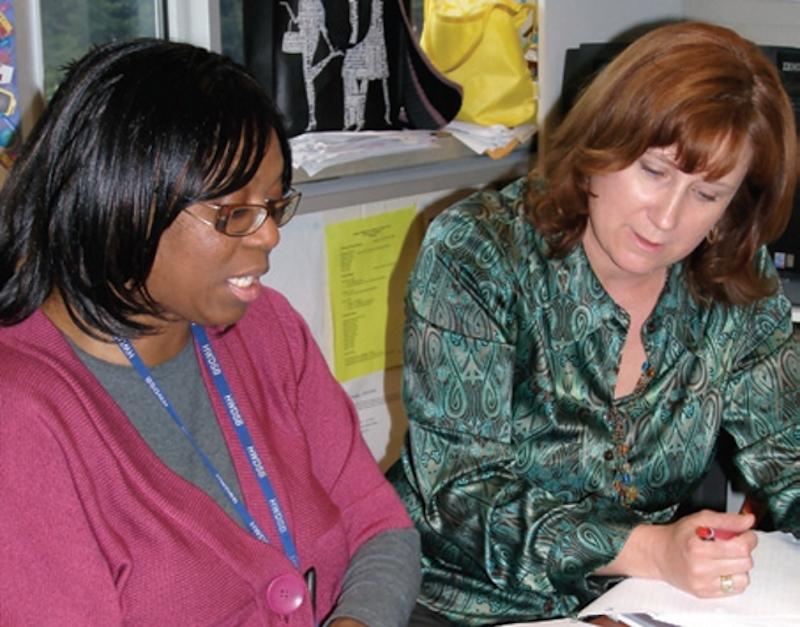
Lead On: A Tale of Two Mentors
Once upon a time two new teachers embarked on their first year of teaching . . .
Thankfully, they did not take this journey alone. As part of the New Teacher Induction Program (NTIP) that started in 2006–2007, newly certified teachers have the opportunity to work directly with and benefit from the leadership of a mentor for a full year.
Mentors play an important role in creating the possibility for happy endings for new teachers: that despite the stress and demands of their first year, they will become highly effective professionals who enjoy a fulfilling career.
Let’s meet two of these mentors.
JO-ANN CORBIN HARPER
Jo-Ann Corbin-Harper is passionate about teaching.
A grade 6 teacher at Ancaster Meadow School, Corbin-Harper has been with the Hamilton-Wentworth DSB for 16 years. Before that, she taught in Barbados. Not one to shy away from leadership roles, she takes on student teachers, has served as a literacy lead, is an ETFO steward, and has led literacy in-services.
Corbin-Harper’s desire to guide others and to help develop their teaching skills led her to become a mentor. She completed the application form (which must include a principal’s recommendation) five years ago and hasn’t looked back.
Her protégé Karen Rashid is in the classroom next door, also teaching grade 6 – an ideal situation. Finding time to meet formally can be challenging; proximity allows for many useful, informal chats, say Rashid and Corbin-Harper.
Witnessing the professional growth of her protégés is Corbin-Harper’s reward: “To see you’ve helped that person develop as a teacher; they’ve taken the ideas you shared and shaped them to be their own.”
She defines a good mentor as “someone who listens, who understands, who is a guide, who knows the curriculum, and who realizes that they can learn from their protégé too.”
Corbin-Harper and Rashid are clearly comfortable with each other, speaking openly and adding a little good-natured humour to the conversation. Mentors do not evaluate their protégés, which allows for this level of trust and comfort. According to ETFO, “A mentor is not a supervisor or an evaluator. A mentor is a colleague, a coach, a support, and a resource.”1
Karen Rashid feels her relationship with Corbin-Harper is one of the greatest advantages of the NTIP program: “Knowing I am not alone, knowing I have someone to support me, having a safety net and a sounding board makes such a difference.”
For mentors there are substantial benefits too. “I’m a little more open-minded, more patient,” Corbin-Harper states. “I love to share ideas and I get fantastic ideas from my protégé. I feel lucky to be able to help shape another person’s career.” Her wish is that more teachers would get involved “to realize the value of the program.”
JENNY SETO-VANDERLIP
This former bank manager turned teacher has taken on many leadership roles. At Ray Lewis School, where she has a grade 5 class, Seto-Vanderlip co-leads peer mediation, hosts student teachers, and is involved with differentiated instruction. She has served on the directions team and as literacy lead, and is currently the math lead.
She has been mentoring for three of the eight years she has been teaching and, like Jo-Ann Corbin-Harper, she is passionate about her profession.
“I like to help take away any fears about teaching and help new teachers understand that teaching is both wonderful and rewarding,” she says. “I love having the ability to share ideas, experiences, to listen, to coach and guide, help others get comfortable in their new job, focus on the positive, and promote everything that is great about teaching. It's all about the kids.” She also likes getting ideas from her protégés and learning from them.
Andrew Thompson, Jenny Seto-Vanderlip’s current protégé, teaches grade 5 and Junior French at Westwood School, seven kilometres away. Their situation does not allow for brief, informal collaboration. Seto-Vanderlip and Thompson meet formally, about once a month. Both enjoy the flexibility of the mentoring program. They receive guidelines, but it is up to them to choose when they will meet and what they do.
Seto-Vanderlip has attended in-services with her protégés and helped with report cards, assessment, and program planning. She has invited her protégés to observe her or a colleague teach.
A good mentor, according to Jenny Seto-Vanderlip, is “available, listens, guides, coaches. It is someone who is positive and someone who loves the job.”
The best part of mentoring she feels occurs when the protégé “has grown, is more confident, and still calls you to share great ideas; there is that continuance of working together.”
Interestingly, both new teachers – Andrew Thompson and Karen Rashid – intend to become mentors themselves. “Mentoring has been absolutely valuable,” says Thompson. “I’ve experienced the benefits and now I can’t wait to mentor in the future.”
Mentors give every first-year teacher the potential to prosper. The hope is that every new teacher’s story ends something like this:
Thanks to the guidance and leadership of a mentor, the protégés survived and thrived during their first year of teaching. They learned that teaching is, indeed, wonderful, and they taught happily and effectively ever after.
EFFECTIVE MENTORING IS…
STRUCTURED and purposeful, based on defined goals developed with the new teacher and addressing specific aspects of teacher development over time.
SUPPORTIVE and conducive to fostering a collegial and collaborative professional learning community within the school that supports professional development and builds professional capacity.
DIFFERENTIATED and tailored to the learning needs of the new teacher, and his or her background and training.3
NOTES
1. “New Teacher Induction Program (NTIP): Performance Appraisal for New Teachers, Role of Mentors,” PRS Matters Bulletin. (Toronto: Elementary Teachers’ Federation of Ontario, March 2007). Available at etfo.ca>Advice for Members>PRS Matters Bulletins.
2. Ibid.
3. Partnering for Success: Getting the Most from Ontario’s New Teacher Induction Program. A Resource Handbook for Mentors (Toronto: OntarioMinistry of Education, 2008), p. 5.

